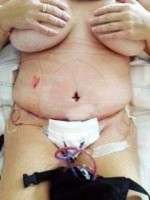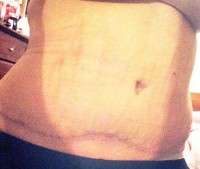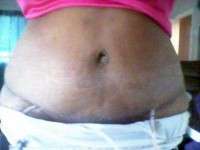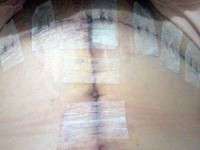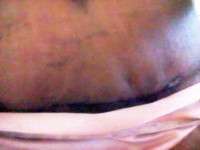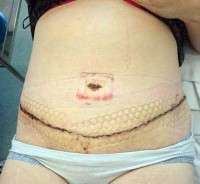Tummy tuck scarring
A tummy tuck uses an incision placed low on the abdomen to remove excess skin and fat from the tummy. A full abdominoplasty places a second incision around the belly button so that the maximum amount of excess skin and fat can be removed. The ideal tummy tuck incision is placed low and flat across the abdomen so that it stays hidden even when wearing a bikini or underwear.
I always try to place the abdominoplasty incision as low as possible, but the patients own skin often dictates the actual height of the tummy tuck scarring. As a result, it is very important to discuss this with your plastic surgeon before your surgery. Sometimes you have decide if you prefer to remove higher stretch marks and have a higher scar or keep the stretch marks and have a lower scar. Your surgeon can help guide you.
Surgery and tummy tuck scarring are inseparable. However, the ultimate appearance of your scar depends upon a number of things. Patient anatomy and healing is just as important as closure technique. Some patient demonstrate a propensity for poor (keloid/hypertrophic) scarring.
The traditional abdominoplasty scar is placed low across the abdomen, from hip to hip. There is also a peri-umbilical incision around the belly button. These scars are generally well tolerated and easily camouflaged by most swimwear.
I recommend that patients bring these garments on the days of surgery so that markings can be adjusted accordingly.
Post operatively, there are a number of things which can be done to minimize the tummy tuck scarring (sun protection, scar massage, silicone sheeting).
As always, discuss your concerns with your board certified plastic surgeon.
The tummy tuck scar is typically designed so that it can be covered with a bathing suit. This is where surgical artistry is very important to give you a scar that ends up low enough and symmetrical. Bear in mind, though, that there will be a scar around your belly button that will not be covered in a two piece bathing suit.
The placement of the tummy tuck scar is placed as low as possible. Where it ends up, however, depends on your anatomy. Almost everybody can find a bikini that will cover the scar. It might not be the super low bikini, but you should be able to show off your new flat abdomen on the beach!
A tummy tuck is one of the most popular plastic surgery procedures because of its predictable results and high patient satisfaction. Patients who undergo a tummy tuck procedure, however, must be willing to accept a transverse incision in their lower abdomen.
Patients are essentially trading the excess skin for a scar, which can be one of the biggest concerns that patients have about the procedure. With this in mind, I take great care to place the incisions and resulting scar in the most discreet location.
Fashion trends have led to lower cut jeans and swimwear which must be considered when placing incisions for a tummy tuck.
I will often have patients wear their desired swimwear or underwear to see where the incision location would be best hidden. It is very common for my abdominoplasty patients to be able to completely cover their scar with a bikini bottom or underwear after the procedure.
Of course the appearance of the scar will vary among patients. It typically takes a year or more for the scar to fade to a more satisfactory shade. I follow my patients very closely after surgery to optimize scar management.
I believe that current trends in fashion greatly influence the placement of tummy tuck scars as well as the techniques a surgeon uses.
As such, the current abdominoplasty scar is placed low and almost flat so that it hides below the waistline of low-cut pants, jeans, underwear, and bathing suit bottoms.
While every patient is different, I usually place the incision below a C-section scar (if there is one) or lower than the fold of the excess abdominal skin. Bringing a sample underwear or bikini to pre-op and/or on the day of surgery helps to ensure that the incision will be properly placed. I like to take tension off of the skin by using multiple layers of sutures. This results in a thin surgical scar that will be hard to see after the redness of healing goes away.
TT scars can be placed very low on the pelvis to maximize concealment. Most of our patients are comfortable wearing a bikini just a few months after TT surgery.
Absolutely, the incisions are made in the natural creases of your bikini area for the purpose of being able to hide the scars, scars will start to dimish within 6 months, so by 1 year you would most definitely be able to wear bikin’s and you scar would not be visible.
When your surgeon designs the location of the subsequent scar that you will have after a tummy tuck, he or she should inquire as to you preferences.
I find it most helpful to have my patients wear the underwear or swimsuit bottom on the day of surgery that they hope to hide the scar beneath. That way I’m able to position the resulting scar in a spot that is most likely to be hidden by the garment they most care about.
Because it is very difficult if not impossible to reposition the scar after surgery, this extra time to confer with the patient about their desires as to scar location is very well spent.
Now, because it is routine to also make an incision around the belly button during a tummy tuck, you must prepare yourself for the scar that will naturally be in that more visible location.
Great care is taken to achieve the best appearing belly button possible, but you must be aware of the potential for a more noticeable scar than you would like. Fortunately, there are many options to deal with a scar that is unfavorable.
You can absolutely have a tummy tuck with the scar hidden below your underpants, and it should be possible to wear a bikini a year later. In some patients with less skin excess, there will be a small vertical scar in the lower abdomen at the site of the old location of the belly button before the skin was pulled down, but this is only the length of the belly button, and if it shows above the bikini line, it can generally be excised by removing some additional skin in a minor office procedure once the skin has relaxed (generally a year after the original procedure).
